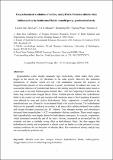Files in this item
Unsynchronized evolution of salinity and pH of a Permian alkaline lake influenced by hydrothermal fluids : a multi-proxy geochemical study
Item metadata
| dc.contributor.author | Xia, Liuwen | |
| dc.contributor.author | Cao, Jian | |
| dc.contributor.author | Stueeken, Eva E. | |
| dc.contributor.author | Zhi, Dongming | |
| dc.contributor.author | Wang, Tingting | |
| dc.contributor.author | Li, Wenwen | |
| dc.date.accessioned | 2021-03-08T00:40:28Z | |
| dc.date.available | 2021-03-08T00:40:28Z | |
| dc.date.issued | 2020-05-20 | |
| dc.identifier | 266864428 | |
| dc.identifier | c0c00fd9-74ab-4352-9e0a-bed63687f211 | |
| dc.identifier | 85081135965 | |
| dc.identifier | 000537202100011 | |
| dc.identifier.citation | Xia , L , Cao , J , Stueeken , E E , Zhi , D , Wang , T & Li , W 2020 , ' Unsynchronized evolution of salinity and pH of a Permian alkaline lake influenced by hydrothermal fluids : a multi-proxy geochemical study ' , Chemical Geology , vol. 541 , 119581 . https://doi.org/10.1016/j.chemgeo.2020.119581 | en |
| dc.identifier.issn | 0009-2541 | |
| dc.identifier.other | RIS: urn:978499399B19DC3966DB413CFF14C91B | |
| dc.identifier.other | ORCID: /0000-0001-6861-2490/work/70619080 | |
| dc.identifier.uri | https://hdl.handle.net/10023/21567 | |
| dc.description | We thank the editor Dr. Hailiang Dong and three anonymous reviewers for their insightful comments and suggestions which greatly improved the manuscript. We thank technical staffs from the Research Institute of Experiment and Testing and Research Institute of Petroleum Exploration and Development of the PetroChina Xinjiang Oilfield Company for their cooperation during this study. This work was jointly funded by National Natural Science Foundation of China (Grant No. 41830425), National Science and Technology Major Project of China (Grant No. 2016ZX05003-005), and PetroChina Science and Technology Major Project (Grant No. 2017E-0401). | en |
| dc.description.abstract | Hyperalkaline waters display unusually high productivity, which makes them prime targets in the search for life elsewhere in the solar system. However, the formation mechanisms of alkaline waters are not well understood, because the response of biogeochemical proxies to these conditions is poorly constrained. To address this issue, we assessed the influence of hydrothermal fluids on the salinity and pH of alkaline lakes based on a case study of an early Permian paleo-alkaline lake (~290 Ma; Fengcheng Formation) in the Mahu Sag, northwestern Junggar Basin, China. Multiple proxies indicate that hydrothermal fluids in the central salt rock and marginal tuff–mudstone areas of the Fengcheng Formation were affected by deep and shallow hydrothermal fluids, respectively. A small part of the transitional area was affected by hydrothermal fluids with a hybrid nature. The hydrothermal fluid activity gradually weakened up-section in all areas while salinity (inferred from carbon and oxygen isotopes) increased and pH (inferred from nitrogen isotopes and mineralogy) decreased from hyperalkaline (>9.25) to moderately alkaline conditions. These trends suggest that hyperalkalinity was largely driven by hydrothermal processes. In contrast, evaporation, which dominated towards the end of the lake's lifetime, maintained an elevated pH but did evidently not have a similarly strong effect as hydrothermal fluids. Our data suggest that hydrothermal activity and evaporation in closed lacustrine basins have the potential to create extreme conditions for the formation of alkaline lakes. The evolution of salinity and pH may not necessarily be synchronized. | |
| dc.format.extent | 2594916 | |
| dc.language.iso | eng | |
| dc.relation.ispartof | Chemical Geology | en |
| dc.subject | Alkaline soda lake | en |
| dc.subject | Nitrogen isotopes | en |
| dc.subject | Hydrothermal fluids | en |
| dc.subject | Reedmergnerite | en |
| dc.subject | Junggar Basin | en |
| dc.subject | Lower Permian Fengcheng Formation | en |
| dc.subject | GE Environmental Sciences | en |
| dc.subject | DAS | en |
| dc.subject.lcc | GE | en |
| dc.title | Unsynchronized evolution of salinity and pH of a Permian alkaline lake influenced by hydrothermal fluids : a multi-proxy geochemical study | en |
| dc.type | Journal article | en |
| dc.contributor.institution | University of St Andrews. School of Earth & Environmental Sciences | en |
| dc.contributor.institution | University of St Andrews. St Andrews Centre for Exoplanet Science | en |
| dc.identifier.doi | https://doi.org/10.1016/j.chemgeo.2020.119581 | |
| dc.description.status | Peer reviewed | en |
| dc.date.embargoedUntil | 2021-03-08 |
This item appears in the following Collection(s)
Items in the St Andrews Research Repository are protected by copyright, with all rights reserved, unless otherwise indicated.

